This traditional Gujarati dal is a beloved staple in our household, so much so that I find myself preparing it several times a week. It’s not just comfort food; it’s a nourishing, soul-satisfying dish packed with a perfect balance of sweet, spicy, and tangy flavors that define authentic Gujarati cuisine. Despite its rich taste, it’s incredibly easy to prepare, making it ideal for both busy weekdays and relaxed weekend meals.
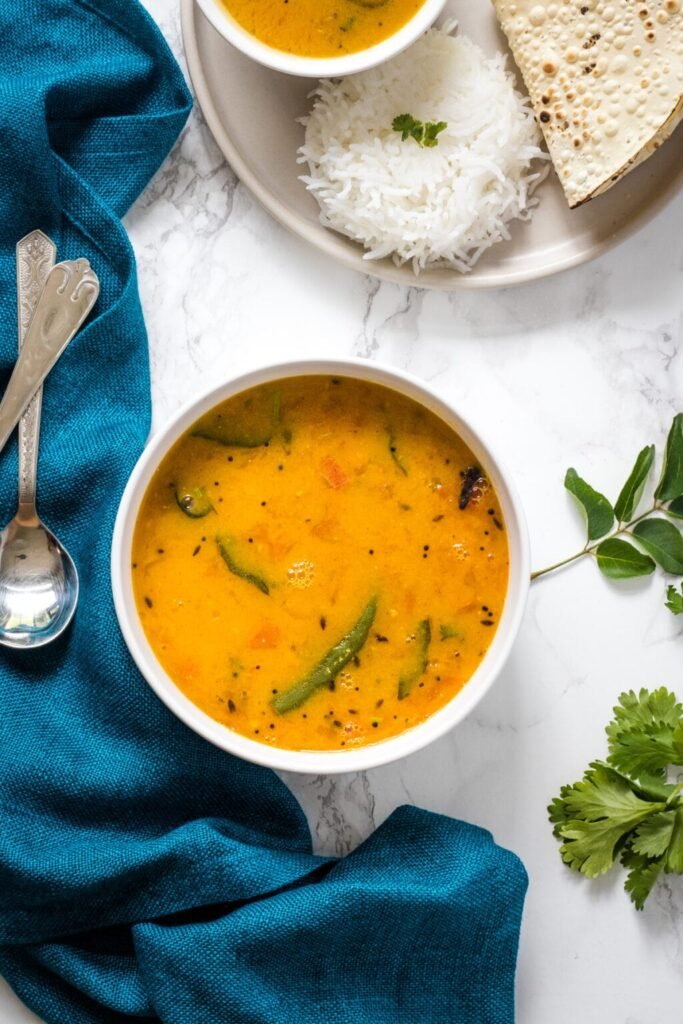
The dal is made with toor dal (split pigeon peas) and a special tempering of mustard seeds, curry leaves, ginger, green chilies, jaggery, and a dash of lemon juice. This unique blend brings together the trademark Gujarati taste—mildly sweet with a subtle kick of spice and just the right hint of tanginess.
For a wholesome and cozy meal, serve this dal steaming hot over a bed of fluffy basmati rice or pair it with soft phulkas (Indian flatbread). Round out the thali with a simple seasonal sabzi, crispy papad, and a spoonful of tangy mango pickle. It’s the kind of everyday comfort food that satisfies both your hunger and your heart.
You’ll Love This Gujarati Dal Recipe
- Perfect Flavor Harmony: This Gujarati dal offers a beautiful balance of flavors—spicy, sweet, and tangy—all blended together in one comforting bowl. The addition of jaggery for sweetness, lemon juice or tamarind for tang, and chilies for heat makes it a signature dish of Gujarat’s diverse palate.
- Nutritious and Protein-Rich: Like most lentil-based dishes, this dal is naturally rich in plant-based protein, making it a healthy and filling addition to your everyday meals. It’s wholesome, light on the stomach, and provides essential nutrients that are ideal for vegetarians.
- A Weekly Staple: As someone from a Gujarati household, this dal is a part of my weekly routine—sometimes even multiple times a week. It’s quick to prepare, budget-friendly, and brings warmth to every meal.
- Great for Meal Prep: This dal is perfect for batch cooking. You can easily make a large quantity and store it in the fridge for 3–4 days. It also freezes well, so you can enjoy the taste of homemade Gujarati dal any time with minimal effort.
- Transform Leftovers Creatively: Got extra dal sitting in the fridge? Don’t let it go to waste! One of the best ways to use leftover Gujarati dal is to turn it into Dal Dhokli—a comforting, hearty dish made by simmering wheat flour dumplings in the dal. In fact, I often make extra dal intentionally, as it allows me to prepare dal dhokli the very next day.
- A Versatile Dish: Whether served with rice, roti, or used as a base for dal dhokli, this dal offers variety and nourishment in every bite.
Ingredient Notes:
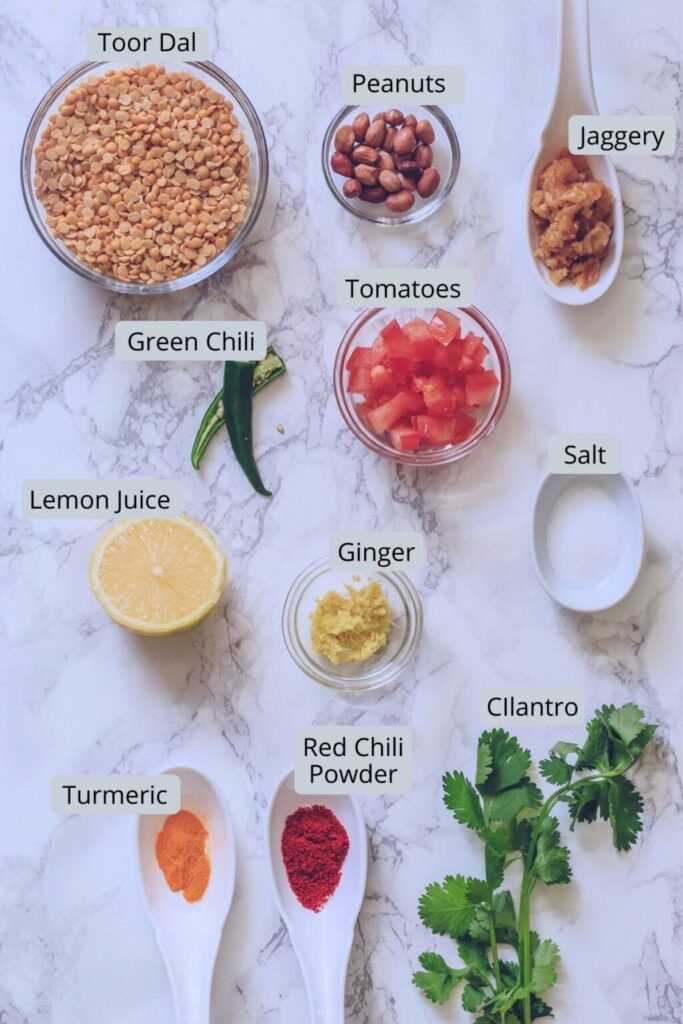
- Arhar Dal (Toor Dal / Split Pigeon Peas): The star of the dish, toor dal, brings a creamy texture and earthy flavor. Rich in protein, it’s a staple in Gujarati households and forms the hearty base of this comforting dal.
- Raw Peanuts: Peanuts are added during the cooking process to introduce a mild crunch and a nutty depth, perfectly complementing the creamy texture of the lentils.
- Water: Water is crucial for achieving the desired consistency of the dal—smooth and easy to pour. Adjust the quantity based on whether you like it thick or slightly runny.
- Red Chili Powder: It adds a mild kick of heat and infuses the dal with a warm, appealing color. Adjust the quantity according to your spice preference.
- Turmeric Powder: A foundational spice that infuses the dal with earthy depth and a radiant yellow hue. It also adds medicinal value with anti-inflammatory properties.
- Chopped Tomato: Adds a slight tang and body to the dal, helping balance the sweetness and spice in the final flavor profile.
- Green Chili (Slit Lengthwise): Used for heat and aroma. You can deseed it to reduce the spiciness or skip if making for kids.
- Ginger (Grated or Paste): Offers a warming, zesty depth. Fresh ginger enhances the overall aroma and digestive value.
- Jaggery (Gur): This key Gujarati touch adds natural sweetness to the dish. It balances out the tangy and spicy flavors, creating a signature sweet-spicy taste.
- Salt (To Taste): Brings all the flavors together. Add it towards the end of cooking for better control.
- Lemon Juice: A splash of acidity at the end brightens the flavor and enhances the dal’s tangy undertone.
- Fresh Cilantro (Coriander Leaves): Chopped and added at the end for freshness, color, and a burst of herbal aroma.
For Tempering (Tadka)
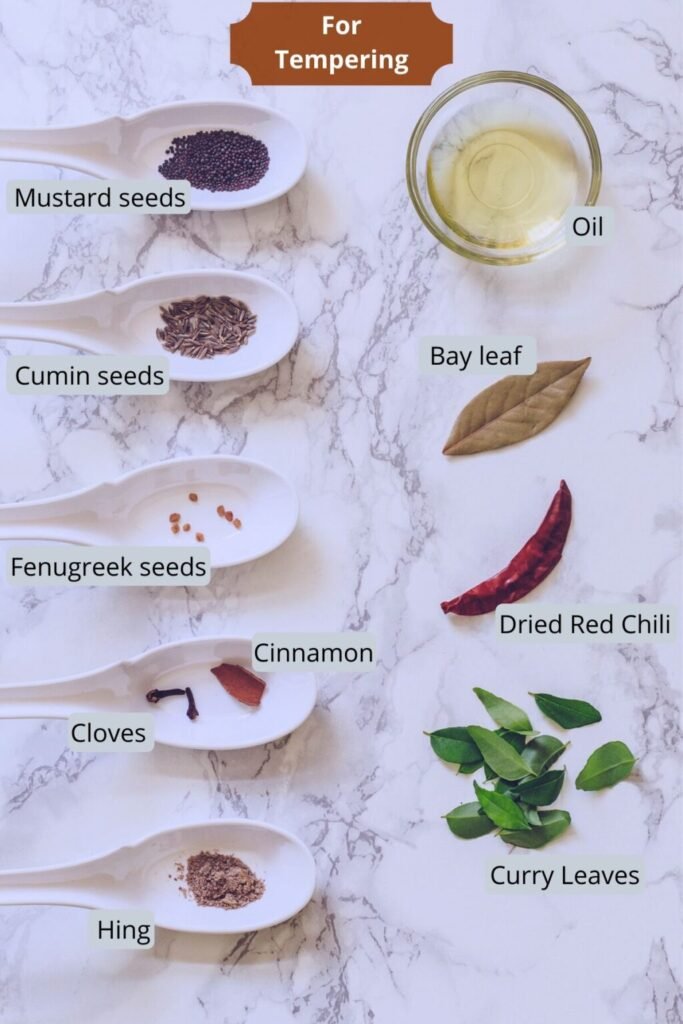
- Oil (Any Neutral Oil or Ghee): Used as a base for blooming spices. Ghee adds a richer flavor, while oil keeps it light.
- Mustard Seeds: A classic tempering ingredient. They crackle in hot oil and release a pungent, nutty flavor.
- Cumin Seeds: Add a warm, earthy aroma that perfectly complements the dal.
- Fenugreek Seeds (Methi Dana): A little goes a long way—these seeds add a distinct bitter note that balances the sweetness of the jaggery.
- Cloves: Infuse a warm and mildly sweet spice, giving depth to the tadka.
- Cinnamon Stick: Adds warmth and a touch of sweetness to the tempering.
- Bay Leaf: Offers a subtle, herbal undertone, enhancing the overall complexity of the flavor.
- Dried Red Chilies (Broken, Seeds & Stem Removed): Used for flavor and appearance. Frying them in oil enhances their smoky, spicy character.
- Curry Leaves: A must for South Asian tempering—fragrant, flavorful, and packed with nutrients.
- Hing (Asafoetida): Just a pinch of this pungent spice elevates the dish with a unique umami flavor. It also aids in digestion, especially when cooking lentils.
How To Make Gujarati Dal?
1) Wash the Toor Dal Well: Begin by thoroughly washing the toor dal (split pigeon peas) under running water until the water runs clear and free of any cloudiness. If you have a little extra time, soak the dal for 15–20 minutes to help it cook faster and more evenly. However, soaking is optional and can be skipped if you’re in a rush.
2) Pressure Cook the Dal with Peanuts: Place the rinsed dal in a pressure cooker along with 1 cup of water. To infuse the dal with a subtle nutty crunch, take a handful of raw peanuts and wrap them in a clean muslin cloth to form a ‘potli’ (small bundle). Place this potli directly in the cooker. Alternatively, put the peanuts in a steel bowl or glass and place it inside the cooker beside the dal.
3) Cook Until Soft and Tender: Secure the lid on the pressure cooker and place the weight. Cook over medium heat for 6 to 7 whistles. After cooking, allow the pressure to release on its own before carefully opening the lid.
4) Separate the Peanuts and Prepare the Dal Base: Carefully remove the peanut potli or bowl and set the boiled peanuts aside. Add 2 cups of water to the cooked dal and blend until smooth using an immersion blender. Traditionally, a wooden churner (madani or valonu) is used for this step, giving the dal a rustic texture.
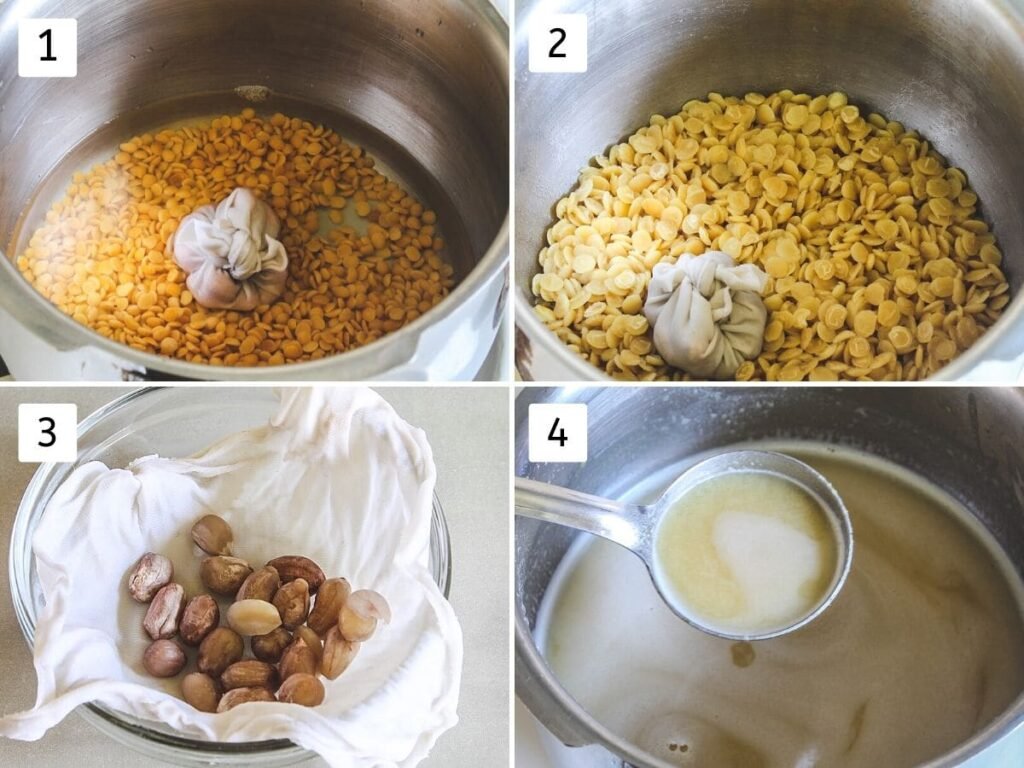
5) Add Spices and Seasonings: Return the pot of dal to medium heat. Stir in the turmeric powder, red chili powder, and salt. These spices do more than just season—they lend the dal its signature golden hue and rich, inviting aroma. Let the mixture simmer gently so the flavors meld beautifully. Next, sprinkle in the turmeric, red chili powder, and salt. Stir well to ensure the spices are evenly distributed throughout the smooth dal, enhancing both its taste and appearance.
6) Incorporate Fresh Ingredients: Stir in chopped tomatoes, freshly grated or crushed ginger, and slit green chilies. These ingredients build a base of fresh and spicy flavors.
7) Sweeten with Jaggery: Add a small piece of jaggery to bring in the signature sweet-tangy balance that defines Gujarati dal. Mix well to dissolve the jaggery completely.
8) Let the dal simmer over medium heat for approximately 10 minutes, allowing the flavors to deepen and the consistency to slightly thicken. Stir occasionally to prevent sticking. Stir occasionally to avoid sticking. If the dal thickens too much during this stage, add a splash of water to maintain a medium-thin consistency. This dal should be light and pourable, not thick like Punjabi dal fry.
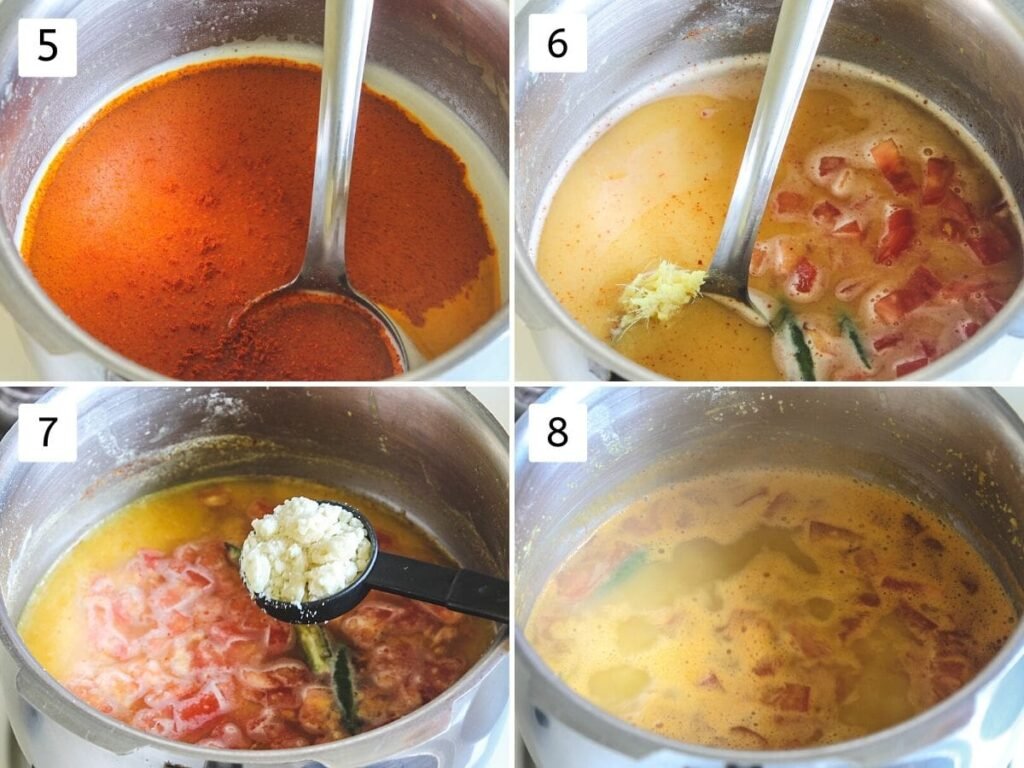
9) Make the Tempering (Tadka): As the dal continues to simmer, prepare the tempering in a small pan. Heat oil over medium flame. Once hot, add mustard seeds and wait until they start to splutter. Next, add cumin seeds and a pinch of fenugreek seeds (methi): Once the mustard seeds begin to splutter, sprinkle in the cumin seeds, followed by a small pinch of fenugreek seeds. Let them sizzle for a few seconds. This step enhances the tempering with a nutty, slightly bitter aroma that balances the sweetness and tang of the Gujarati dal beautifully. Allow them to sizzle and release their aroma, which will add a robust, earthy flavor to the dal.
10) Enhance with Whole Spices: Add a bay leaf, a small stick of cinnamon, a couple of cloves, and a few dried red chilies (break them in half and remove the seeds if you prefer less heat). These whole spices infuse the oil with deep, warming flavors that elevate the dal’s overall taste. Sauté for about 30–40 seconds until the aroma of the spices fills the kitchen.
11) Finish the Tempering: Add fresh curry leaves and a generous pinch of asafoetida (hing) to the hot oil. Sauté the spices briefly until fragrant, then immediately pour the hot tempering over the gently simmering dal. This quick transfer locks in the aroma and infuses the dal with deep, layered flavors from the tempered spices. This step locks in the flavor and gives the dal its signature fragrant finish. Mix thoroughly to combine the rich, spiced oil with the dal.
12) Final Touch and Serve: Add the reserved boiled peanuts, a splash of lemon juice for tang, and freshly chopped coriander leaves. Stir well and serve hot with steamed rice, roti, or the traditional side of sabzi, papad, and mango pickle.
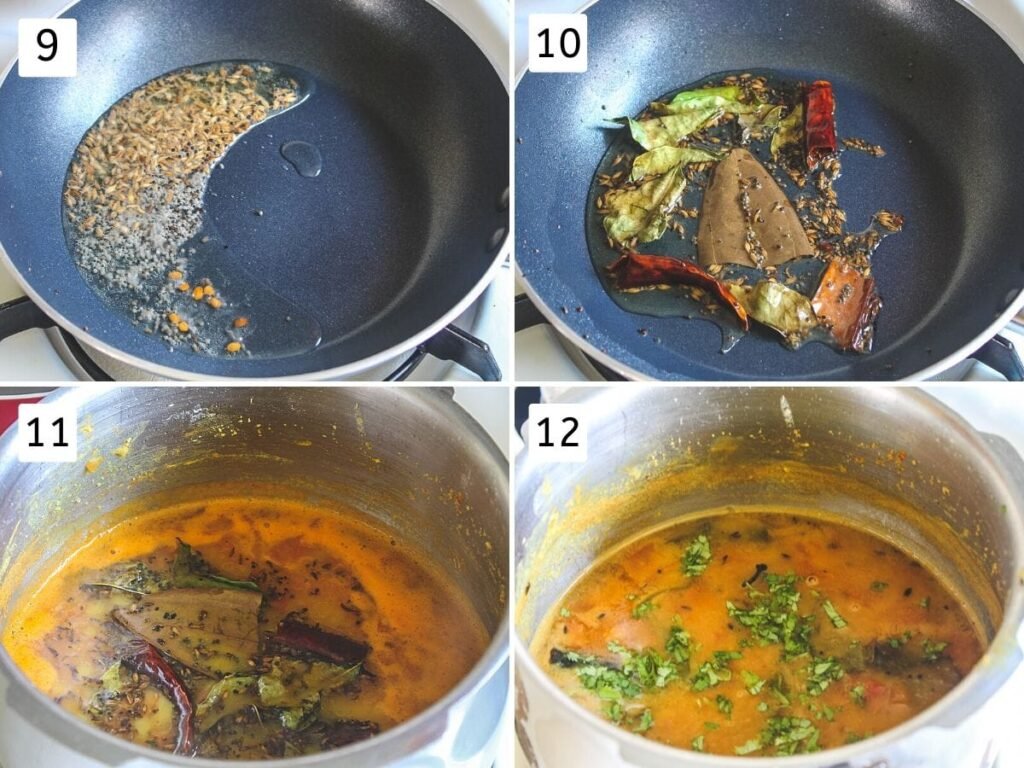
Expert Tips:
- Ideal Consistency of Gujarati Dal: A traditional tip from my grandmother—after resting the dal in a bowl for a few minutes, you should notice the water gently rising to the top while the lentils settle at the bottom. This subtle separation is a hallmark of perfectly cooked Gujarati dal with the right medium-thin consistency.
- Shortcut for Boiling Peanuts: Instead of tying peanuts in a muslin cloth or adding them to the pressure cooker, you can simply microwave them in water for a couple of minutes until soft. It’s a quicker and equally effective method.
- When to Add Lemon Juice: Always stir in the lemon juice at the very end, once the simmering process is complete. Adding it too early may dull its brightness or cause a slight bitterness due to prolonged cooking.
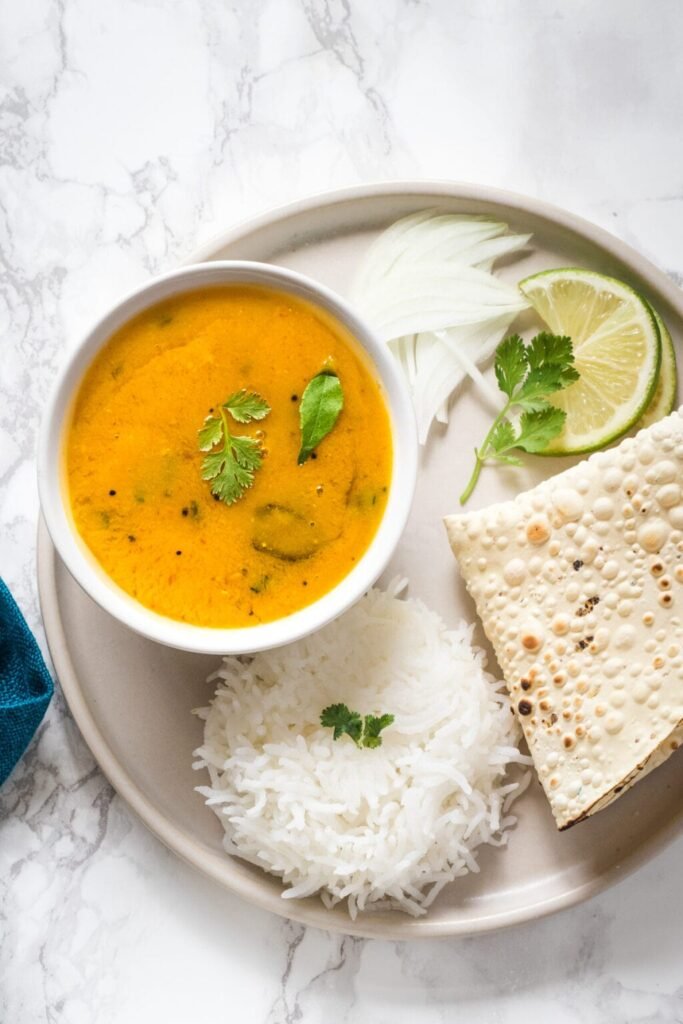
Serving Ideas for Gujarati Dal:
- Light Consistency, Yet Not Filling Alone:
- Gujarati dal is known for its medium-thin texture, which is comforting but not very heavy on the stomach. Because of this light consistency, a simple bowl of dal with rice may not feel completely filling on its own. That’s why, in a typical Gujarati home, this dal is served as just one part of a more elaborate meal rather than the main dish.
- A Key Component of the Traditional Gujarati Thali:
- This flavorful dal finds its rightful place in the classic homestyle Gujarati thali. A regular thali usually features a well-balanced combination of dishes that complement each other. You’ll often find:
- Gujarati Dal, topped with a spoonful of desi ghee for extra richness
- Steamed rice (bhaat)
- Rotli (thin whole wheat flatbreads)
- Shaak, a dry or semi-dry spiced vegetable preparation
- Optional but common additions include chilled chaas (spiced buttermilk), crispy papad, and a spoonful of mango or lemon pickle for that extra zing. Together, these components create a meal that is both satisfying and nutritionally balanced, perfect for lunch or dinner in a Gujarati household.
